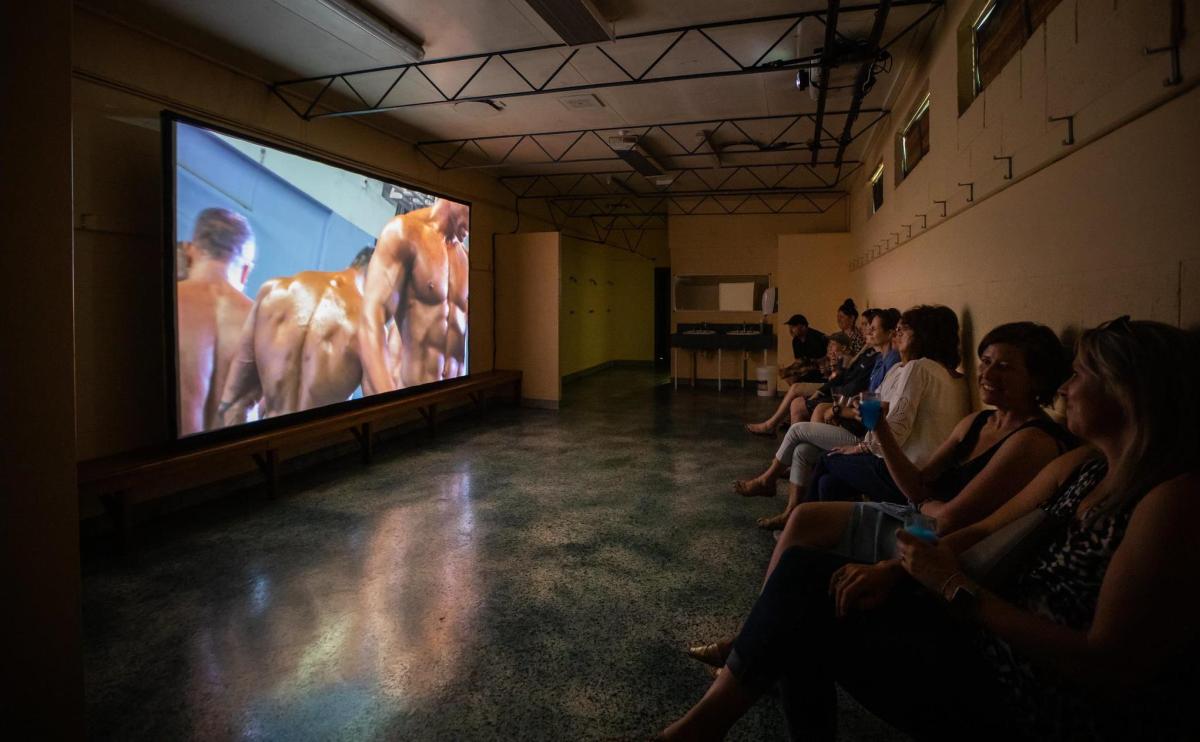Mona Foma’s The Centre takes over a local gym complex. Curators Emma Pike and Pippa Mott have seized this opportunity to install works by video artists throughout the site. Their selection of works speaks of communities, identity, bodily refinement and a fascination with physical commitment.
Khaed Sabsabi’s Wonderland (2014) sets the tone. In the open space of a timber basketball court, two huge screens display a group of official club supporters and their devoted leaders. Nothing of the game is seen by the audience. Sabsabi’s focus is on the complex dynamics of the crowd of young men. Their familiar gestural language reinforces identity; their passion evident in sweat. Born in Lebanon and currently living and working in Sydney, this artist’s work addresses the bonds that distil group diversity into a single identity.
In a change room next door, Katy B Plummer covers her performers from head to ankle in Beast Trinity (2019). Plummer juxtaposes components of handmade textiles with the practical artefacts of gridiron protection. The three performers develop a narrative of contact that builds to collision. The focus shifts as tackle models are utilised to position the bodies in space.
In contrast, the muscle-bound bodies in Turkish artist Ali Kazma’s Body Building (2013) are stripped and dehydrated to the max. On parade, these finely tuned and oiled human roosters manoeuvre themselves for intimate scrutiny.
Pike and Mott have chosen another cavernous space for Liz Magic Laser’s work Kiss and Cry (2015). This time the audience is offered some comfort, allowing for more relaxed contemplation. Unlike the previous works, the voices of the participants are heard as they enact their training. Self-talk overlapped with scripted speeches sets up a disturbing tension between the disciplined worlds of both children and adults.
Also deserving a full-length viewing is Run Free (2013) by Piotr Wysocki and Domininik Jalowinski, in which young men vault over and through buildings, and a formation of riot police march in their heavy padding. In a collaboration, volunteer police offer themselves as props in a creative challenge with their working-class free-runner foe. This work is viewed in a small cage-like space at the top of a staircase.
Below, in the Table Tennis Hall, C’mon (2006) by Tony Schwensen shows the artist-as-tennis-player struggling through a seemingly purposeless activity. At eight hours long, it’s the bounds of audience endurance he seems to be pushing.
Other works chosen by Pike and Mott include Gymnasium by Tarryn Gill and Pilar Mata Dupont (2010), with its study of white-shirted saccharine smiles, and Harlequins V’s Visitors (2012), a closeup of vocal warm ups sung by the Sydney Chamber Choir (Jess Olivieri and Hayley Forward with the Parachutes for Ladies).
The least obvious choice of for inclusion focuses on the actions of a mollusc’s limb, in Alexandra Bachzetsis’ A to B via C (2015), which seems a mismatch with Pike and Mott’s socially conscious themes, but remains a fascinating study of the physical feats and coordination of an octopus and of the muscle-clad humans attempting to replicate it.
A work by Hissy Fit is also on display at the Queen Victoria Museum & Art Gallery in Inveresk.
4 stars out of 5 ★★★★
The Centre
Curated by Emma Pike and Pippa Mott for MONA FOMA 2020
Artists: Tarryn Gill + Pilar Mata Dupont, Jess Olivieri + Hayley Forward with the Parachutes For Ladies, Ali Kazma, Liz Magic Laser, Katy B Plummer, Khaled Sabsabi, Tony Schwensen, Dominik Jałowiński + Piotr Wysocki
14-19 January 2020
Elphin Sports Centre, Launceston TAS
Free





